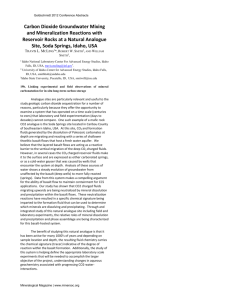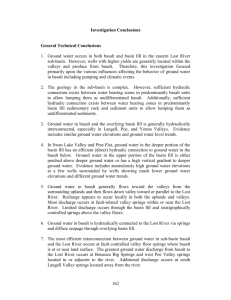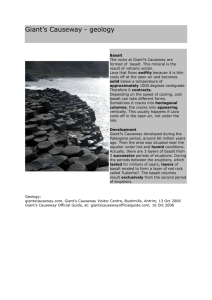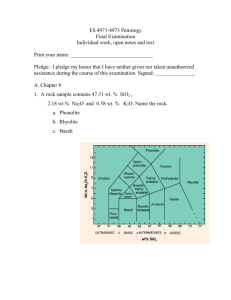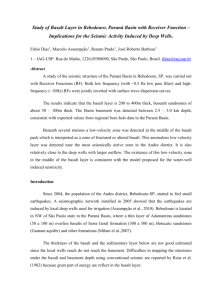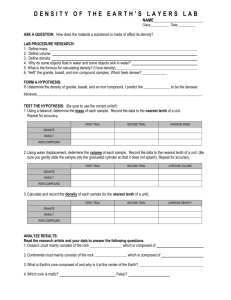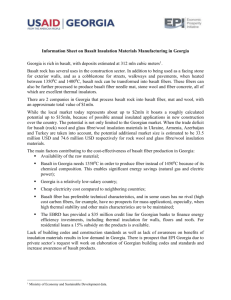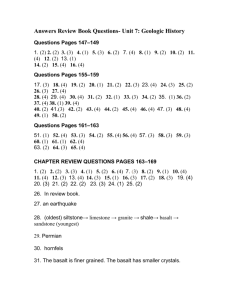GW_Rpt_41_Exec_Summary - Water Resources Department
advertisement
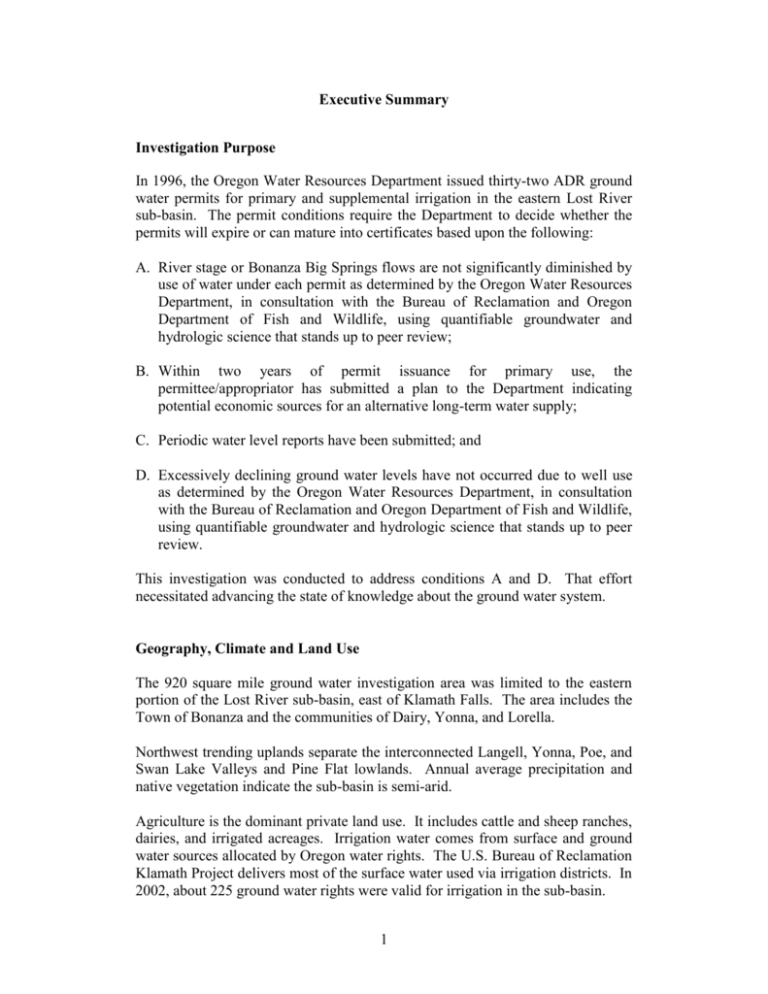
Executive Summary Investigation Purpose In 1996, the Oregon Water Resources Department issued thirty-two ADR ground water permits for primary and supplemental irrigation in the eastern Lost River sub-basin. The permit conditions require the Department to decide whether the permits will expire or can mature into certificates based upon the following: A. River stage or Bonanza Big Springs flows are not significantly diminished by use of water under each permit as determined by the Oregon Water Resources Department, in consultation with the Bureau of Reclamation and Oregon Department of Fish and Wildlife, using quantifiable groundwater and hydrologic science that stands up to peer review; B. Within two years of permit issuance for primary use, the permittee/appropriator has submitted a plan to the Department indicating potential economic sources for an alternative long-term water supply; C. Periodic water level reports have been submitted; and D. Excessively declining ground water levels have not occurred due to well use as determined by the Oregon Water Resources Department, in consultation with the Bureau of Reclamation and Oregon Department of Fish and Wildlife, using quantifiable groundwater and hydrologic science that stands up to peer review. This investigation was conducted to address conditions A and D. That effort necessitated advancing the state of knowledge about the ground water system. Geography, Climate and Land Use The 920 square mile ground water investigation area was limited to the eastern portion of the Lost River sub-basin, east of Klamath Falls. The area includes the Town of Bonanza and the communities of Dairy, Yonna, and Lorella. Northwest trending uplands separate the interconnected Langell, Yonna, Poe, and Swan Lake Valleys and Pine Flat lowlands. Annual average precipitation and native vegetation indicate the sub-basin is semi-arid. Agriculture is the dominant private land use. It includes cattle and sheep ranches, dairies, and irrigated acreages. Irrigation water comes from surface and ground water sources allocated by Oregon water rights. The U.S. Bureau of Reclamation Klamath Project delivers most of the surface water used via irrigation districts. In 2002, about 225 ground water rights were valid for irrigation in the sub-basin. 1 Geologic Framework (compiled from other investigations) The geology of the upper Klamath basin and the eastern Lost River sub-basin is complex. The upper Klamath basin is located in the transition area between the Cascade Mountain and the Basin and Range physiographic provinces. The eastern Lost River sub-basin is located within the Basin and Range province. The province is characterized by long and narrow, north-south trending fault-block mountains separated by broad basins filled with sedimentary rock and sediments. The stratigraphy of the sub-basin consists of numerous units of basalt and sedimentary rock and sediments. Many units are contemporaneous with complex relationships. Water influenced the deposition of many units. Some units show evidence of hydrothermal alteration or secondary mineralization that followed deposition. Geologically young (3.8 to 8.2 million years) basalt occurs throughout the subbasin as multiple layers with some sedimentary interbeds between layers. Unit thickness ranges from less than 50 ft to approximately 2,000 ft. Individual flows may be discontinuous and can vary in texture. Depositional environments range from subaerial, to some interaction with water, to submerged. Some units show gradations indicating they experienced multiple depositional environments. Most exposed basalt occur in the uplands. In the valleys, basin fill sedimentary rock and sediments bury the basalt units except at buttes. Sub-basin sedimentary rock and sediments predominantly occur in the valleys as lacustrine, fluvial, and volcaniclastic basin fill that overlies the basalt. The thickness of the basin fill can range from a few feet to hundreds of feet. Some basalt dikes, sills, and flows are found within the basin fill. The general sub-basin geologic structure includes numerous north-northwest trending and occasional east-west trending faults. Most of the faults vertically offset geologic units creating upland blocks (horsts) with steep escarpments along the fault. Down-dropped blocks (grabens) form valleys between the horsts. Geologic History (compiled from Black, 2004) The oldest exposed rocks in the sub-basin are late Miocene (7.32 and 8.18 million year age dates) basalts found on Bryant Mountain and Gift Butte. They were deposited as thin horizontal sheets erupted over subdued topography. The units show interaction with water, and lacustrine sedimentary interbeds occur between some flows. These flows are assumed to underlie the entire sub-basin. 2 Master Basin and Range faulting commenced about 7 million years ago. This started erosion of fully emplaced basalt units creating low hills and broad valleys. Lacustrine mudstone and fluvial deltaic sandstone accumulated in the developing basins during a period of volcanic inactivity. The mudstone came from volcanic ash from nearby eruptive centers. Volcanic activity in the sub-basin eventually resumed (5.4 million year maximum age date, 4.6 to 3.8 million year age for most samples), and non-master faults that produced buttes and other small uplands within the valleys commenced about 4.5 million years ago. Eruptions occurred along master graben-bounding faults and within the basins. Flows erupted onto the sediments, flowed into the basins and up against the basaltic highs, locally ponded, and/or interacted with water over large areas. More recently during the Pleistocene, pluvial Lake Modoc purportedly inundated the sub-basin valleys in addition to the Upper Klamath Lake and Tule Lake valleys. The lake elevation apparently fluctuated rising to a maximum elevation of 4,240 ft. During this period, lacustrine deposition occurred within the lake, Miller Creek formed a gravel delta as it flowed into the lake, and other alluvial fans were deposited by other drainages. When Lake Modoc receded, it left behind Upper Klamath Lake, Tule Lake, Alkali Lake, and Swan Lake. Additionally, the Lost River was established. Subsequently, some sedimentary deposition has occurred. No evidence has been found for volcanism occurring in the sub-basin during the Pleistocene to the present. Ground Water Occurrence Water well reports indicate ground water occurs in both basalt and basin fill sedimentary rocks and sediments. Despite the complex geology in the sub-basin, sufficient hydraulic connection exists between water bearing zones in predominantly basalt units to allow lumping them as undifferentiated basalt. Additionally, sufficient hydraulic connection exists between water bearing zones in predominantly basin fill sedimentary rock and sediment units to allow lumping them as undifferentiated sediments. Ground water in basalt and the overlying basin fill is generally hydraulically interconnected, especially in Langell, Poe, and Yonna Valleys. Evidence includes similar ground water elevations and ground water level trends. In Swan Lake Valley and Pine Flat, ground water in the deeper portion of the basin fill has an efficient (direct) hydraulic connection to ground water in the basalt below. Ground water in the upper portion of the basin fill is either perched above deeper ground water or has a high vertical gradient to deeper ground water. Evidence includes anomalously high ground water elevations at a few wells surrounded by wells showing much lower ground water elevations and different ground water trends. 3 Data indicate four sub-areas exist in the eastern Lost River sub-basin: south Langell Valley, Lorella, Bonanza, and Swan Lake Valley to Poe Valley. In addition, nine compartments exist within the Lorella sub-area and three compartments exist in the Swan Lake Valley to Poe Valley sub-area adjoining the central portion of the sub-area. The compartment boundaries are poorly defined, but they likely correspond to buried geologic structures. Ground Water Temperatures The temperature range of ground water in basalt and the basin fill is similar. The reported ground water temperatures for 157 wells completed in basalt range from 45 to 90oF. The reported ground water temperatures for 24 wells completed in sediments range from 45 to 80oF. The higher temperatures indicate the presence of water heated during deep circulation. Hydraulic Properties of Basalt and Basin Fill Water well reports indicate the hydraulic properties of the basalt and basin fill generally differ. The reported yield of 199 wells completed in basalt range from 4 gal/min minimum to 5,500 gal/min maximum. The average and median yields are 1,470 and 1,500 gal/min respectively. The reported yield of 44 wells completed in basin fill sediments range from 2 gal/min minimum to 950 gal/min maximum. The average and median yields are 82 and 30 gal/min respectively. Aquifer tests were conducted at various sub-basin locations to determine the hydraulic properties of basalt. The Oregon Water Resources Department, the U.S. Geological Survey, and CH2MHill consultants conducted the tests. The aquifer test data yielded a range of hydraulic property values. Transmissivity varies by sub-area and sub-area compartments, ranging from less than 50,000 ft2/d (375,000 gal/d/ft) to over 100,000 ft2/d (750,000 gal/d/ft). Storage coefficient values are generally less than 10-3 with most close to 10-4. Many of the tests showed the influence of no-flow boundaries and/or responses from recharge boundaries, leaky confining layers, or delayed yield. Ground Water Flow Ground water in basalt generally flows toward the valleys from the surrounding uplands and then flows down valley toward or parallel to the Lost River. Recharge appears to occur locally in both the uplands and valleys. Most discharge occurs at fault-related valley springs within or near the Lost River. Limited discharge occurs through the basin fill and stratigraphically controlled springs above the valley floors. The occasional hot springs present are fault controlled with water absorbing heat during deep circulation along faults. 4 The geologic influence upon horizontal ground water flow in basalt varies. As previously noted, data indicate four sub-areas exist in the eastern Lost River subbasin: south Langell Valley, Lorella, Bonanza, and Swan Lake Valley to Poe Valley, and compartments exist within the Lorella sub-area and the Swan Lake Valley to Poe Valley sub-area. Water level data show relatively small horizontal hydraulic gradients (change in ground water elevation for a given horizontal distance) exist in most sub-area valleys. This indicates low resistance to flow within a given sub-area valley, even in areas with numerous geologic structures and geologic units that are discontinuous or changing in character. Structures in these areas are transparent to flow rather than impede flow. Steeper gradients exist at valley margins, neighboring uplands, and between sub-areas, sub-area compartments, and neighboring sub-basins. The larger gradients in these areas indicate higher resistance to flow by the geologic structures and units. The vertical ground water gradient within the sediments, between the sediments and basalt, and within basalt range from downward to upward depending upon location relative to recharge or discharge areas. Sets of relatively concurrent surface water flow measurements (seepage run data) confirm the ground water in basalt is hydraulically connected to the Lost River. Free flowing springs occur within and adjacent to the river at Bonanza and western Poe Valley. They respectively discharged about 60 and 20 ft 3/s to the river in December 1997. Other springs located away from the river discharge to the river via ditches and/or overland flow. Elsewhere, discharge from the basalt to the river occurs as diffuse, low flow, seepage through the overlying basin fill. Influences Upon Ground Water Elevations Climate influences the elevation of ground water in basalt. The annual ground water elevation trend generally declines during years of below average precipitation and rises during years of above average precipitation. Additionally, barometric pressure changes (expressed as feet of water) inversely changes the ground water elevation at some wells with 30 to 50 percent efficiency. Investigation data also revealed earth tides can influence ground water in basalt causing the ground water elevation to fluctuate, generally less than 0.1 ft. Canal leakage occurs within the sub-basin. It notably influences ground water in basalt in the Lorella sub-area in mid Langell Valley. The elevations rise when the canals flow and decline when canals are empty. In most areas, however, a canal influence upon ground water in basalt is not apparent in the water level data. This is because aquifer properties help dissipate the canal influence, and climate and ground water use masks the canal influence. 5 Lost River stage can influence the elevation of ground water in basalt. However, the influence appears limited. Ground water use clearly influences ground water in both the basalt and sediments. Most ground water elevations decline during major ground water use periods (the irrigation season) and recover during periods of reduced or no use. Limited data indicate ground water near land surface in basin fill responds to irrigation, precipitation, and snowmelt events. These events appear as short-term spikes on water level hydrographs. The influence of these short-term events upon ground water deeper in the basin fill is dampened and lost with depth. Ground Water Response to Development Ground water use in the sub-basin has increased over the decades. The ADR permit condition D requires the Oregon water Resources Department to determine whether “excessively declining ground water levels” have occurred due to well use. The definition exists in Oregon Administrative Rule OAR 690-08-001 (6). Water level measurements at nine state observation wells (generally from the 1960s through the 1990s) indicate ground water levels in the sub-basin decline and recover seasonally and over multiple years. The seasonal fluctuations correspond to the seasonality of ground water recharge and ground water use. The fluctuation over multiple years corresponds to long-term precipitation trend variations. At eight of the nine sites, water levels during the late 1990s are similar to the initial levels. Over a 40-year period, a possible decline of 1 to 2 ft occurred in south Swan Lake Valley, Yonna Valley, and south Langell Valley, and a possible 3 ft decline may have occurred near Lorella. These declines are not considered “excessive” as defined by OAR 690-08-001 (6). At the ninth site located in southeast Poe Valley, a 20 ft total decline occurred as two 10 ft steps, first in the 1960s and subsequently in the 1990s. The decline resulted from local aquifer properties and compartmentalization amplifying ground water use impacts during droughts. The decline is notable, a concern, and deserves continued monitoring. However, it is geographically limited and not considered “excessive” as defined by OAR 690-08-001 (6). Under the rule, an “excessive” decline includes water quality deterioration as a result of “ongoing lowering” of the ground water level. Periodic ground water quality deterioration has occurred in the vicinity of Bonanza Big Springs as a result of drought, seasonal ground water use, and management of the Lost River. This situation is not considered an “excessive” decline under OAR 690-08-001 (6) since the deterioration is not related to an “ongoing lowering” of ground water levels. 6 Ground Water Drawdown Calculations To address ADR permit condition A, this investigation calculated the potential drawdown of ground water in basalt at the Lost River, Bonanza Big Springs, and other springs due to pumping ground water as allowed by the ADR permits. River and spring sites selected for the drawdown calculations were limited to sites within the same sub-area or compartment as the pumping well. The interference affect on the Lost River and springs due to pumping ground water from basalt is directly proportional to the ground water drawdown in basalt at the river and springs. Larger drawdowns cause larger affects at the river and spring. The rate of ground water discharge to a river via springs and seepage decreases as the ground water level above river stage falls. Discharge ceases when the ground water level equals river stage. Then, the rate of reverse flow (river water loss to ground water) increases as the ground water level falls below river stage. Drawdown from a pumping well at any location is dependent upon the pumping rate, aquifer transmissivity and storage coefficient, distance from the pumping well, and elapsed pumping time. Higher pumping rates, smaller transmissivity, and storage coefficient, shorter distance from the pumping well, and longer elapsed time lead to larger drawdown estimates. Conversely, smaller pumping rates, larger transmissivity and storage coefficient, greater distance from the pumping well, and shorter elapsed time lead to smaller drawdown estimates. For each ADR permit, a drawdown was calculated at the closest Lost River site in the same sub-area or compartment as the ADR permit well, a different site for each permit. These individual drawdowns represent the maximum ground water drawdown pumping a given well will cause at the river. Again for each ADR permit, a drawdown was calculated at one of three springs if present in the same sub-area or compartment as the ADR permit well. The springs are Bonanza Big Springs in the Bonanza sub-area, Kilgore Spring in the south Langell Valley sub-area, and High spring in the central portion of the Swan Lake Valley to Poe Valley sub-area. The ADR permit conditions address Bonanza Big Springs only. In addition to these individual drawdowns, the principle of superposition allowed calculating a cumulative drawdown at the spring sites, all the calculated drawdowns at a spring added together. 7 The drawdown calculations included using continuous pumping at the maximum rates allowed by the ground water permits and pumping at pro-rated rates. Given the permits specify a maximum pumping rate allowed, it was necessary to calculate ground water drawdowns using that rate. However, irrigators rarely use the maximum pumping rate for the entire period of use for a variety of reasons. Therefore, it was necessary to calculate ground water drawdowns using pro-rated pumping rates. The pro-rated pumping rates were obtained by dividing the total volume of water allowed by the total period of use allowed. The calculated cumulative ground water drawdown in basalt at Kilgore Spring in the south Langell Valley sub-area for 30 and 184 days of continuous pumping at the maximum permitted rate ranged from nearly 3.00 ft to more than 3.50 ft respectively. The total drawdown for 30 and 184 days of pro-rated pumping ranged from nearly 1.75 ft to more than 2.00 ft respectively. The calculated cumulative ground water drawdown in basalt at Bonanza Big Springs in the Bonanza sub-area for 30 and 184 days of continuous pumping at the maximum permitted rate ranged from more than 5.40 ft to nearly 7.25 ft respectively. The total drawdown for 30 and 184 days of pro-rated pumping ranged from nearly 3.10 ft to more than 4.10 ft respectively. The calculated cumulative ground water drawdown in basalt at High spring in the central portion of the Swan Lake Valley to Poe Valley sub-area for 30 and 184 days of continuous pumping at the maximum rate permitted ranged from nearly 3.00 ft to less than 5.00 ft respectively. The total drawdown for 30 and 184 days of pro-rated pumping ranged from over 1.50 ft to over 2.50 ft respectively. All the calculation results by ADR permit and sub-area can be found in tables in the full report. Each calculation conducted can be found in the report appendices. Conclusions 1. Ground water occurs in both basalt and basin fill in the eastern Lost River sub-basin. However, wells with higher yields are generally located within the valleys and produce from basalt. Therefore, this investigation focused primarily upon the various influences affecting the behavior of ground water in basalt including pumping and climatic events. 2. No “excessively declining ground water levels”, as defined in Oregon Administrative Rule OAR 690-08-001 (6), occurred before, or subsequent to, issuance of the ADR permits. 3. Long-term water level trends in basalt generally correlate with climatic trends. An exception is a step-wise decline in southeast Poe Valley. 8 4. Short-term ground water level fluctuations in basalt (annual decline and recovery) correspond to annual pumping and precipitation patterns. 5. The study area can be divided into four sub-areas based primarily on the behavior of ground water in basalt and in part on geology. At different locations within each sub-area, the ground water response to natural and anthropogenic stress is similar. Some sub-areas can be further divided into compartments based on the behavior of ground water affected by geologic structure. 6. Water level data from 1999 through 2002 indicate the impacts of summer ground water pumping from basalt did not propagate beyond sub-area or compartment boundaries during those years. This does not imply the subareas and compartments are hydraulically isolated or that any long-term effects, such as year-to-year declines, from future ground water uses will not propagate to neighboring areas in the long-term. 7. Ground water in basalt is hydraulically connected to the Lost River via springs and diffuse seepage through overlying basin fill. 8. Investigation data indicate springs showing an acute response to seasonal ground water pumping from basalt were located in the same sub-area or compartment as the seasonal ground water use. For example, Bonanza Big Springs responded to summer ground water use in the Bonanza sub-area only. This does not imply that long-term effects from any future ground water uses will not propagate in the long-term to affect springs in neighboring sub-areas or compartments. 9. The effect of pumping ground water from basalt upon surface water is proportional to the amount of ground water drawdown caused by the pumping and the efficiency of the interconnection between the ground water in basalt and surface water. 10. The most efficient interconnection between ground water in sub-basin basalt and the Lost River occurs at fault controlled valley floor springs where basalt is at or near land surface. The greatest ground water discharge from basalt to the Lost River occurs at Bonanza Big Springs and west Poe Valley springs located in or adjacent to the river. Additional discharge occurs at south Langell Valley springs located away from the river. 11. The least efficient interconnection between ground water in sub-basin basalt and the Lost River is through basin fill that overlies the basalt. Ground water discharge to the river occurs as diffuse, low flow, seepage. 9 12. High basalt transmissivities exist in the Bonanza and south Langell Valley sub-areas and the central portion of the Swan Lake Valley to Poe Valley subarea. These transmissivities facilitate smaller, but very rapid ground water level responses at springs and other locations within the same sub-area or compartment where pumping ground water from basalt occurs. Even though the water level response at a spring is small, the impact upon spring discharge is large given the higher transmissivities and direct connection between the basalt and springs. Most of the ADR permit wells are located in these areas, especially the Bonanza sub-area. 13. Low basalt transmissivities and compartmentalization generally exist in the Lorella sub-area and in south and eastern Poe Valley. These facilitate greater ground water level drawdown when a well pumps from basalt in these areas. Despite the greater water level response, the short-term impact upon surface water is small in these areas. This is due to the lower transmissivities, compartmentalization, and/or thicker basin fill making the interconnection between the basalt and surface water inefficient. Fewer of the ADR permits are located in these areas. 14. From 1997 through 2002, the ground water level in the basalt at Bonanza Big Springs nearly met the river stage in the summer of 1997 and 2000, and dropped below the river stage in the summer of 2001 and 2002. 15. Under current management of the Lost River, the calculated total ground water drawdown in basalt by pro-rated pumping of the Bonanza sub-area ADR permit wells is sufficient to terminate Bonanza Big Springs flow (lower the ground water level to or below river stage) in most years. 16. Fewer ADR ground water permit wells are located in the central portion of the Swan Lake Valley to Poe Valley sub-area where a direct connection with High spring exists, and the south Langell Valley sub-area where a direct connection with Kilgore Spring exists. In 2001, both springs stopped flowing due the lowering of ground water levels in the basalt caused by drought and increased pumping. 10
